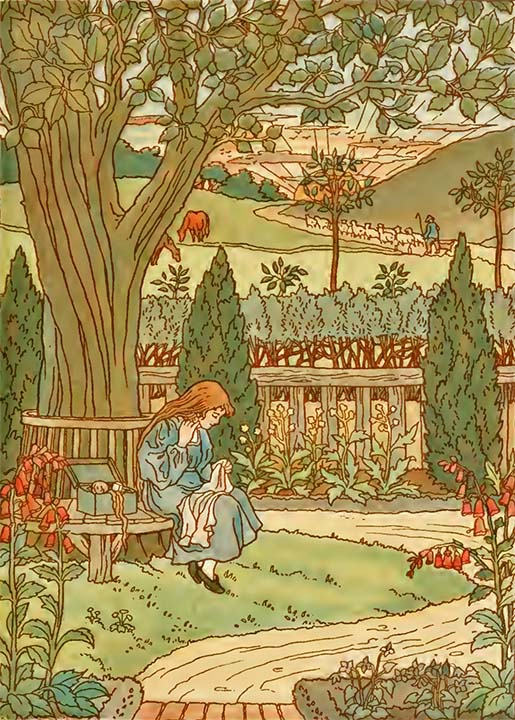Good Night and Good Morning
A fair little girl sat under a tree
Sewing as long as her eyes could see;
She smoothed her work and folded it right,
And said, 'Dear work, good night, good night.'

Full Version:
A fair little girl sat under a tree
Sewing as long as her eyes could see;
She smoothed her work and folded it right,
And said, 'Dear work, good night, good night.'
Such a number of rooks flew over her head,
Crying 'Caw! Caw!' on their way to bed,
She said, as she watched their curious flight,
'Little black things, good night, good night.'
The horses neighed and the oxen lowed,
The sheep' s bleat, bleat, came over the road,
All seeming to say, with a quiet delight,
'Dear little girl, good night, good night!'
She did not say to the sun Good night,
Though she saw him there like a ball of light,
For she knew he had God's time to keep,
All over the world and never could sleep.
The tall pink foxglove bowed his head,
The violet curtsied and went to bed.
And good little Lucy tied up her hair,
And said on her knees her evening prayer.
And while on the pillow she softly lay,
She knew nothing more till again it was day,
And all things said to the beautiful sun,
'Good morning! Good morning! our work has begun.'
Origins
Unlike many nursery rhymes that grew out of playground chants or village songs, this one began as a literary poem. It was written by Richard Monckton Milnes, better known as Lord Houghton (1809–1885). Milnes was a Victorian poet and politician, but this gentle piece for children, usually called Good Night and Good Morning, outlived most of his other works.
But there’s more to it than just a bedtime chant. The poem carries a very Victorian idea of childhood — that children were little models of innocence, expected to live neatly, stay close to nature, and be guided by faith. You can see it most clearly when Lucy decides not to say “good night” to the sun, because it is “keeping God’s time.” For a Victorian reader, that moment tied the child’s small world to something eternal.
At the same time, the poem captures the way children imagine the world around them. To Lucy, the rooks aren’t just noisy birds, the foxgloves aren’t just flowers — they’re companions who join her in saying good night. Everything around her becomes part of one big, friendly circle.
Meaning
At first glance, it’s a sweet bedtime routine in verse. A little girl, Lucy, says good night to her sewing, to the rooks in the sky, to the farm animals, and to the flowers around her. She kneels for her evening prayer and falls asleep. By morning, the cycle reverses — everything greets the rising sun.
 The poem captures the way children imagine the world around them. To Lucy, the rooks aren’t just noisy birds, the foxgloves aren’t just flowers — they’re companions who join her in saying good night. Everything around her becomes part of one big, friendly circle.
The poem captures the way children imagine the world around them. To Lucy, the rooks aren’t just noisy birds, the foxgloves aren’t just flowers — they’re companions who join her in saying good night. Everything around her becomes part of one big, friendly circle.
Poems like this were part of the Victorian nursery bookshelf. They were written to be read aloud by parents or governesses, often with the aim of teaching manners, faith, and gratitude. The tone is softer than a sermon but more pointed than a playful rhyme.
Illustrations often showed Lucy surrounded by farm animals, flowers bowing their heads, or rooks sweeping across the evening sky. The effect was to make bedtime feel not lonely but shared — as if the whole natural world was going to sleep at the same time.

